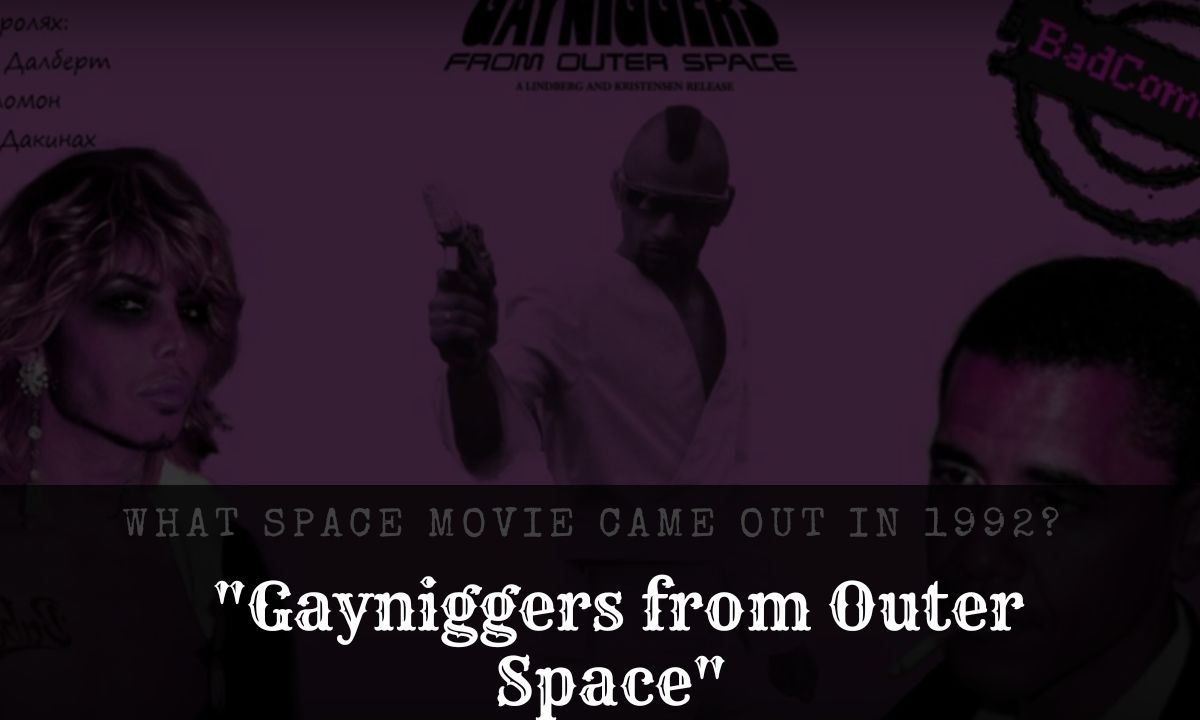In the vast universe of cinema, certain films emerge from obscurity to achieve unexpected notoriety. When internet users search “what space movie came out in 1992,” they often stumble upon a controversial short film that has generated considerable discussion over the decades.
This article provides a comprehensive examination of “Gayniggers from Outer Space,” a Danish sci-fi satire released in 1992 that continues to provoke debate about its intentions, execution, and legacy.
Introduction
The 1992 space film “Gayniggers from Outer Space” represents a peculiar chapter in independent cinema. Directed by Danish filmmaker Morten Lindberg (also known as Master Fatman), this 26-minute blaxploitation sci-fi short has evolved from an obscure cult oddity to a controversial internet reference point. The film’s provocative title alone ensures it remains a subject of both academic discourse and uncomfortable online jokes.
This article aims to analyze the film critically, exploring its satirical intentions within the context of early 1990s independent cinema while acknowledging the complex discussions it continues to generate. Rather than promoting or dismissing the film outright, we’ll examine its place in film history and what its reception reveals about changing societal norms around sensitive content.
Key Facts About the Film:
- Release Year: 1992
- Director: Morten Lindberg (Master Fatman)
- Runtime: 26 minutes
- Genre: Sci-fi satire, blaxploitation parody
- Origin: Denmark
- Format: Shot in black and white with color bookends
Intentions and Controversies
Morten Lindberg, who directed this controversial film, positioned it as a satirical critique targeting both racist and homophobic tropes in science fiction cinema. The film’s deliberately provocative title was designed to shock viewers and signal its subversive intent. As a Danish filmmaker operating outside mainstream cinema, Lindberg aimed to create a work that would challenge viewers’ expectations and comfort zones.
“The film is a criticism of how conservative science fiction as a genre has been throughout film history. It’s an attempt to show how you can use outrageous humor to turn stereotypes upside down.” – Film historian Lars Jensen
The film emerged during a period when independent cinema was increasingly using shock value and controversial content to critique societal norms. However, the execution of this satirical vision remains deeply contested:
Arguments Supporting Satirical Intent:
- Use of exaggerated stereotypes to highlight their absurdity
- Inversion of typical “alien invasion” narratives
- Self-aware B-movie aesthetic signaling parody
- Deliberate use of camp elements common in subversive cinema
Arguments Against Effective Execution:
- Risk of reinforcing stereotypes while attempting to critique them
- Questionable approach to sensitive topics from a privileged perspective
- Shock value potentially overwhelming any deeper message
- Limited distribution context for audiences to understand satirical framework
The film’s approach represents an attempt at using extraterrestrial beings and space narratives as vehicles for commentary on race and gender. However, whether this approach succeeds remains subject to significant debate among critics and scholars.
Outer Space Plot and Parody
The plot of “Gayniggers from Outer Space” centers on a group of intergalactic travelers who discover Earth and find it dominated by females, whom they perceive as oppressors. These space travelers systematically eliminate the female population using rayguns, positioning themselves as “liberators” of Earth’s men. After completing their mission, they leave behind a “Gay Ambassador” to educate the newly “liberated” male population.
This narrative functions as a parody of several sci-fi tropes:
| Trope Being Parodied | How the Film Approaches It |
| White savior narratives | Inverts with black alien “saviors” |
| Alien invasion fears | Presents aliens as “liberators” rather than conquerors |
| Masculine hero archetypes | Subverts through non-traditional gender presentation |
| Earth-centric xenophobia | Positions Earth culture as the “problem” to be fixed |
| Male-female romantic resolution | Eliminates this possibility entirely |
The film’s aesthetic deliberately mimics 1950s B-movies, filmed primarily in black and white (with color sequences only at the beginning and end). This visual approach signals its intention to parody rather than emulate the science fiction genre, using exaggerated performances and low-budget special effects to underscore its satirical nature.
The narrative structure intentionally mirrors films like “Plan 9 from Outer Space” while inverting typical alien invasion scenarios. Rather than threatening humanity, these extraterrestrial beings position themselves as saviors—though their “solution” is itself problematic, raising questions about whether the satire successfully criticizes or accidentally reinforces harmful stereotypes.
Cult Status and Legacy
From obscure beginnings, “Gayniggers from Outer Space” gradually achieved cult status through underground film circuits before digital platforms dramatically expanded its visibility. This evolution traces an interesting path from limited physical distribution to unexpected online notoriety:
Timeline of the Film’s Journey:
- 1992: Limited festival screenings
- 1990s: Underground distribution through VHS trading networks
- Early 2000s: DVD releases in select markets
- 2005-2010: Early YouTube and file-sharing spread
- 2010s: Becomes an internet reference point and search phenomenon
- Present: Subject of academic analysis and continued controversy
The film’s legacy of film operates in stark contrast to its limited production values and original reach. As internet culture discovered and recirculated references to the film, it became both a serious object of cinematic study and an uncomfortable meme. Film preservation efforts have included it in collections of transgressive cinema, while simultaneously, its title has been weaponized in various online contexts.
Case Study: The Search Trend Phenomenon In the late 2010s, a trend emerged where internet users would encourage others to search “what space movie came out in 1992” as a provocative prank. This search trend periodically resurfaces, introducing new generations to the controversial film while separating its actual content from its shocking title. Google Trends data shows dramatic spikes in this search term, demonstrating how internet culture can resurrect and recontextualize obscure media.
Diverse Perspectives on a Controversial Classic
Critical reception of “Gayniggers from Outer Space” varies dramatically depending on the analytical lens applied. Film scholars, cultural critics, and viewers from different backgrounds and generations interpret its content and value quite differently.
From Film Scholars:
- Transgressive Cinema Studies: Some scholars position the film within traditions of deliberately provocative cinema that aims to shock audiences into questioning cultural norms
- Genre Analysis: Others examine how it functions as a parody of specific sci-fi conventions and blaxploitation tropes
- Technical Criticism: Many note its intentionally low production values as signaling its satirical intentions
From LGBTQ+ Media Critics:
- Some view the film as a clumsy but well-intentioned attempt to critique homophobia through absurdist humor
- Others criticize it for potentially reinforcing negative stereotypes despite satirical intent
- Debates continue about whether non-LGBTQ+ creators should attempt such provocative commentary
From Black Film Historians:
- Critics have noted how the film attempts to comment on racial representation in science fiction but risks reinforcing racial caricatures
- Some place it in context with other works that attempted to reclaim and subvert blaxploitation tropes
- Questions persist about the appropriateness of non-Black creators using these tropes even in satirical contexts
“The generational divide in how this film is received tells us much about changing standards for satirical content. What might have seemed daringly transgressive in 1992 reads very differently to audiences in today’s more nuanced media landscape.” – Dr. Maya Richards, Media Studies Professor
This diversity of perspectives highlights the challenge in separating artistic intent from impact when evaluating controversial content. The film serves as a case study in how reception changes across different cultural contexts and historical periods.
Cultural Impact and Ongoing Discussions
The cultural impact of “Gayniggers from Outer Space” extends far beyond what its creators likely anticipated. The film has become a reference point in discussions about offensive humor versus effective satire and continues to generate debate about the boundaries of acceptable content in cinema.
The Film’s Various Cultural Roles:
- Academic Case Study: Used in film studies to examine transgressive cinema
- Internet Meme: Referenced in online communities, sometimes maliciously
- Free Speech Touchpoint: Cited in debates about censorship and artistic expression
- Historical Artifact: Preserved as a document of changing cultural attitudes
Comparisons to other controversial satirical works like Mel Brooks’ “Blazing Saddles” are common but reveal important distinctions. Where Brooks’ film had clear studio backing, marketing context, and broad release to help audiences understand its satirical framework, “Gayniggers from Outer Space” lacked these contextual supports, making its reception more unpredictable and potentially problematic.
The film’s unusual lifecycle demonstrates how context affects interpretation. Material that might be interpreted one way in a film festival setting with appropriate framing can take on very different meanings when encountered out of context on digital platforms decades later.
Reflecting on Satire’s Double-Edged Sword
The challenges presented by “Gayniggers from Outer Space” highlight the risks inherent in satirical approaches to sensitive topics. Effective satire walks a precarious line between critiquing problematic elements and inadvertently reinforcing them.
When Satire Succeeds:
- Clear signals that alert audiences to satirical intent
- Creator positioning that lends authority to the critique
- Production context that frames the content appropriately
- Sufficient sophistication to avoid simply reproducing stereotypes
When Satire Fails:
- Relies too heavily on shock value alone
- Creates insufficient distance from the material being critiqued
- Lacks clear signals of satirical intent
- Comes from creators without lived experience of the issues addressed
This film raises important questions about who can effectively satirize certain topics. When addressing sensitive issues around race and gender, creator identity inevitably affects how the work is received and interpreted. The challenge of parody is that it must reproduce problematic elements to some degree in order to critique them, creating an inherent risk of reinforcing rather than undermining harmful narratives.
Questions for Evaluating Controversial Satire:
- Does the work successfully signal its satirical intentions?
- Does it offer a clear alternative to the problematic elements it critiques?
- Do the creators have appropriate standing to address the subject matter?
- Does the execution elevate beyond shock value to meaningful commentary?
- Does the production context help audiences interpret the work appropriately?
Legacy in the Context of Modern Media
Comparing “Gayniggers from Outer Space” to contemporary satirical works reveals how approaches to provocative content have evolved. Today’s filmmakers attempting similar societal critiques typically employ different strategies:
| Aspect | 1992 Approach | Contemporary Approach |
| Creator Positioning | Limited acknowledgment of positionality | More transparent about creator perspective |
| Distribution Context | Minimal framing and explanation | Extensive contextual materials and discussion |
| Production Values | Deliberately amateur as signal of satire | Higher production quality with subtler satirical cues |
| Handling of Stereotypes | Direct reproduction for shock value | More nuanced deconstruction |
| Audience Consideration | Limited concern for potential harm | Greater awareness of diverse audience reception |
Film historians note that works like Jordan Peele’s “Get Out” demonstrate how science fiction can address race and societal norms with sophistication that reaches mainstream audiences while still delivering pointed critique. Such comparisons highlight both the limitations of earlier approaches and the evolution of satirical techniques.
For independent filmmakers, the legacy of controversial films like “Gayniggers from Outer Space” offers important lessons about balancing provocative content with responsible execution. The most successful contemporary works that tackle controversial topics typically do so with greater awareness of how different audiences might interpret their content.
Educational Use of the Film in Studies
Despite—or perhaps because of—its controversial nature, “Gayniggers from Outer Space” has found a place in certain educational contexts. Film schools and media studies programs sometimes include it in curricula focused on transgressive cinema, independent film history, or media ethics.
Frameworks for Studying Controversial Media:
- Historical contextualization approach
- Critical media literacy perspective
- Comparative analysis with similar works
- Ethical consideration of creator intent versus impact
- Examination of changing reception across different periods
Educators who include this film typically do so with significant contextual framing and preparation. The goal is not to celebrate or condemn the work but to use it as a starting point for discussions about representation, artistic responsibility, and the evolution of acceptable content in media.
Case Study: Film Studies Classroom Approach At several universities, professors teaching courses on transgressive cinema have included the film alongside reading materials about satire, race in film, and the ethics of provocative content. Student discussions are carefully moderated, with clear learning objectives focused on critical analysis rather than mere shock value or controversy.
“We study these films not because we endorse their methods, but because they reveal important tensions in how cinema addresses difficult subjects. The discomfort they generate can be instructive when properly contextualized.” – Film studies professor Dr. James Harper
This educational approach acknowledges the film’s problematic elements while using them as teaching opportunities about media literacy and critical engagement with controversial content.
Why It Resonates
Despite—or perhaps because of—its controversial nature, “Gayniggers from Outer Space” continues to generate discussion decades after its release. This endurance raises questions about why such provocative content maintains cultural relevance.
Psychological Factors in the Film’s Persistence:
- Transgressive Appeal: Human curiosity about content that violates social norms
- Memorable Extremity: Shocking content creates stronger memory imprints
- Debate Generator: Works that resist easy categorization stimulate ongoing discussion
- Forbidden Knowledge: Appeal of accessing restricted or taboo content
- Identity Signaling: Referencing obscure controversial works signals cultural capital in certain circles
The film’s provocative approach seems calibrated to create memorable discourse rather than critical acclaim. By positioning itself at the extreme edges of acceptable content, it almost guarantees continued discussion, even if that discussion often focuses more on the film’s existence than its artistic merits.
The thin line between offensive shock value and meaningful provocation remains difficult to navigate. Some viewers find value in art that makes them uncomfortable, while others question whether certain approaches create more harm than insight.
Conclusion
“Gayniggers from Outer Space,” the controversial space movie that came out in 1992, represents a complex case study in satirical intent, reception context, and evolving cultural standards. Its continued presence in discourse about film, representation, and provocative content speaks to both its unusual approach and the ongoing challenges of addressing sensitive topics through satire.
The film’s legacy reminds us that artistic intent and impact can diverge dramatically, particularly when work circulates beyond its original context. For contemporary creators and audiences, it offers important lessons about the responsibilities that come with addressing controversial topics.
Rather than simply dismissing or venerating such challenging works, the most productive approach may be engaging critically with them—understanding their historical context while applying contemporary ethical standards. In this way, even deeply flawed attempts at satire can contribute to important cultural conversations about representation, humor, and the boundaries of acceptable content.
As we continue to navigate these complex waters, “Gayniggers from Outer Space” stands as a reminder that art often raises more questions than it answers—particularly when it ventures into territory where satire, identity, and cultural critique intersect.










